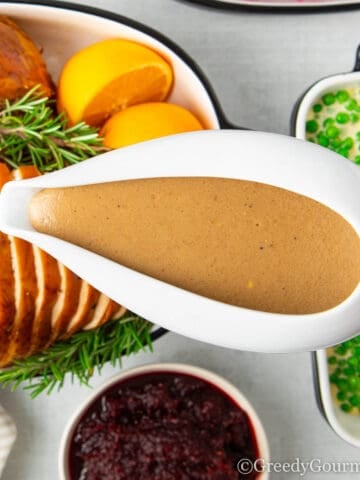It's impossible to resist the heavenly aroma of perfectly grilled yakitori chicken, marinated in or dipped in this amazing, caramelized yakitori sauce.

It's amazingly easy to make, with only four ingredients, all of which harmonize to create a magical flavor that tantalizes the taste buds. So, are you ready for a little taste of Japan? Read on for my guide on how to make the perfect yakitori sauce.
Why you'll love this yakitori sauce recipe
- A sumptuous savory sauce that has an incredibly rich flavor
- Perfect for yakitori chicken skewers
- Incredibly simple to make
- All ingredients are easily sourced
Equipment needed
There are a few important you'll need to make this yakitori sauce recipe:
- Saucepan – this is the key piece of kitchen equipment, which you'll use to mix up and heat your yakitori sauce
- Sauce bottle – store your homemade yakitori sauce the right way
How to make yakitori sauce

Place the sugar, soy sauce, mirin and rice vinegar in a pot. Stir over a medium heat until the sugar has dissolved and then simmer the sauce for 5 minutes until slightly thicked. Set aside and let it cool. Use as needed.
Top Tip
You can buy quality sake and mirin from your local Asian supermarket or a specialist store.
How to use yakitori sauce
Yakitori sauce, known for its sweet-savory flavor profile, is versatile and can be used in various culinary applications beyond just yakitori. Here are some different ways to use it:
Basting and Grilling
- Yakitori: Traditionally used for basting grilled chicken skewers (yakitori) while grilling to create a flavorful glaze.
- Other Meats: Excellent for basting other meats like beef, pork, or lamb skewers.
- Seafood: Works well with grilled fish or shrimp, adding a sweet-savory glaze.
Marinade
- Meat and Poultry: Use as a marinade for skinless chicken thighs, beef, pork, or lamb before grilling, baking, or broiling.
- Seafood: Marinate fish or shrimp for a few hours before cooking for enhanced flavor.
Dipping Sauce
- Appetizers: Serve as a dipping sauce for appetizers like spring rolls, dumplings, or tempura.
- Skewers: Provide as a dipping sauce for grilled chicken skewers or any other skewers to enhance their flavor.
Stir-fry Sauce
- Vegetables: Use as a stir-fry sauce for vegetables like broccoli, bell peppers, and snap peas.
- Noodles: Toss with noodles (such as soba, udon, or ramen) for a quick and flavorful dish.
Glazing Sauce
- Roasted Vegetables: Drizzle over grilled veggies like carrots, Brussels sprouts, or green beans.
- Tofu: Brush over baked or grilled tofu for added flavor.
Would you like to save this?
Condiment
- Rice and Grain Bowls: Drizzle over rice bowls, quinoa bowls, or poke bowls for added flavor.
- Burgers and Sandwiches: Use as a condiment for burgers, sandwiches, or wraps.
Salad Dressing
- Asian-inspired Salads: Mix with a bit of sesame oil and rice vinegar to create a flavorful dressing for Asian-inspired salads.
Braising Liquid
- Braised Dishes: Use as part of the braising liquid for slow-cooked dishes like short ribs, pork belly, or chicken thighs.
Sauce for Rice
- Plain Rice: Drizzle over steamed white or brown rice for an easy flavor boost.
- Fried Rice: Use as a seasoning for fried rice, adding a rich, umami flavor.

Popular substitutes
- Soy Sauce: For a gluten-free option, use tamari or gluten-free soy sauce. You can also use dark soy sauce.
- Mirin: If you don't have mirin, you can use a combination of rice vinegar and sugar as a substitute (for every 1 tablespoon of mirin, use 1 tablespoon of rice vinegar plus ½ teaspoon of sugar).
- Sake: Dry sherry or Chinese rice wine can be used as a substitute for sake if unavailable. For a non-alcoholic option, use additional mirin or water.
- Brown Sugar: You can use white sugar, honey, or maple syrup as an alternative to brown sugar, although the flavor profile will slightly change.
Variations to this recipe
- Sweeter Sauce: Increase the amount of brown sugar by 1-2 tablespoons for a sweeter sauce.
- Spicy Sauce: Add a pinch of red pepper flakes or a small amount of sriracha to the sauce while simmering for a spicy kick.
- Garlic and Ginger: Although the traditional recipe provided is without garlic and ginger, adding 2 cloves of minced garlic and ½ teaspoon of grated fresh ginger can enhance the flavor, making it richer and more aromatic. You can also add green onions to the sauce.
- Thicker Sauce: For a thicker sauce, you can dissolve 1 tablespoon of cornstarch in 2 tablespoons of cold water and add it to the sauce while simmering. Stir continuously until the sauce thickens to your desired consistency.
- Extra heat: Add a dash of hot sauce to give this yakitori sauce a kick.
What is yakitori?
Yakitori refers to traditional Japanese-style grilled chicken skewers. The word is a combination of two words – “grilled” (yaki) and “chicken” (tori).
Traditionally, yakitori skewers are cooked over hot Japanese charcoal on a rectangle-shaped grill. They are flavored with yakitori sauce, either marinated in the sauce beforehand or dipped in the sauce after they're grilled.
What is yakitori sauce?
Traditional yakitori sauce is a combination of four ingredients:
Mirin
This sweet Japanese cooking wine is a major component of many Japanese recipes. It has a sweet and tangy flavor, with a thick almost syrupy consistency which is key to achieving the texture of yakitori sauce.
Soy sauce
Regular soy sauce is often used, although dark soy sauce can bring a darker coloring and a richer flavor to yakitori sauce.
Sake
Also known as Japanese rice wine, sake is a hugely popular drink in Japan that's also used for cooking. Sake varies a lot in terms of its flavor profile, but is typically dry or sweet with a clean finish and a hint of umami flavor.
Brown sugar
A touch of brown sugar adds some subtle sweetness, key to balancing out the savory flavors in the sauce.
What does yakitori sauce taste like?
It's subtly sweet, salty and slightly smoky with a hint of tang and a whole lot of umami.
Is yakitori and teriyaki sauce the same?
No. While they both have a soy sauce base, teriyaki sauce includes ginger and garlic, giving it an earthier, slightly spicy quality.

What are the origins of yakitori sauce?
Yakitori cuisine is said to have originated in Tokyo during the Meiji period in the 1880s. This was a period of modernization and experimentation in Japanese culture, especially regarding cuisine.
How do you store yakitori sauce?
Refrigeration:
Allow the sauce to cool completely after cooking. Transfer it to an airtight container or a clean bottle/jar. Homemade yakitori sauce will keep in the refrigerator for up to 1 month.
Can you freeze yakitori sauce?
Yes.
To freeze yakitori sauce:
Allow the sauce to cool completely.
Transfer the sauce to a freezer-safe container or freezer bag, leaving some space at the top as the sauce may expand when frozen.
Label the container with the date.
Freeze for up to 3 months.
When defrosting yakitori sauce:
Place the frozen sauce in the refrigerator overnight to thaw slowly. Alternatively, if you need it quickly, place the sealed container or bag in a bowl of cold water to thaw.
How do you reheat yakitori sauce?
When it comes to reheating yakitori sauce, you have a couple of options:
Stovetop:
Pour the desired amount of sauce into a small saucepan.
Heat over low to medium heat, stirring occasionally, until warmed through.
Microwave:
Transfer the desired amount of sauce to a microwave-safe container.
Cover with a microwave-safe lid or plastic wrap (leave a small vent).
Microwave on medium power in 30-second intervals, stirring in between, until warmed through.
Tips:
If the sauce thickens too much after being stored or frozen, you can add a small amount of water or sake to thin it out to the desired consistency while reheating.
Always reheat only the amount you need to prevent repeatedly reheating and cooling the entire batch, which can affect the quality and safety of the sauce.
More sublime sauce recipes
Feeling saucy? Check out these recipes:
- Adobo sauce – a fiery Mexican sauce that will elevate your favorite dishes
- Curry base sauce – this simple curry base sauce is so easy to make and will open you up to a whole world of Indian cuisine
- White sauce – a highly versatile sauce that you'll go back to again and again
- Romesco sauce – a smoky, nutty Catalan sauce that's perfect with meats and vegetables
📖 Recipe

Yakitori Sauce Recipe
- Total Time: 20 minutes
- Yield: 6 servings 1x
- Diet: Low Lactose
Description
Discover the rich, savory flavors of homemade Yakitori Sauce with this easy recipe, perfect for enhancing your grilled chicken skewers.
Ingredients
- 1 cup soy sauce
- 1 cup mirin
- ½ cup sake
- ¼ cup brown sugar
Instructions
- Combine Ingredients: In a small saucepan, combine the soy sauce, mirin, sake, and brown sugar.
- Heat and Dissolve Sugar: Bring the mixture to a boil over medium-high heat, stirring to ensure the sugar dissolves completely.
- Simmer and Thicken: Once boiling, reduce the heat to medium-low and let it simmer for about 10-15 minutes, or until the sauce has thickened slightly and glossy.
- Cool and Store: Remove the sauce from heat and let it cool. Transfer the cooled sauce to a clean bottle or jar.
- Storage: The sauce can be stored in the refrigerator for up to a month.
Notes
- Basting: The quantity of sauce provided will be enough to thoroughly baste 1kg of chicken.
- Dipping/Drizzling: There should be enough leftover sauce for 4 to 6 servings, depending on how generously the sauce is used.
- Prep Time: 5 minutes
- Cook Time: 15 minutes
- Category: Sauce
- Method: Boil
- Cuisine: Japanese
Nutrition
- Serving Size:
- Calories: 186
- Sugar: 27.6 g
- Sodium: 1360.2 mg
- Fat: 0.1 g
- Saturated Fat: 0 g
- Trans Fat: 0 g
- Carbohydrates: 33.4 g
- Fiber: 0.1 g
- Protein: 3.3 g
- Cholesterol: 0 mg









val
Wow, this recipe was absolutely delicious! Tried it with chicken but next time I'll do it with pork. Thanks